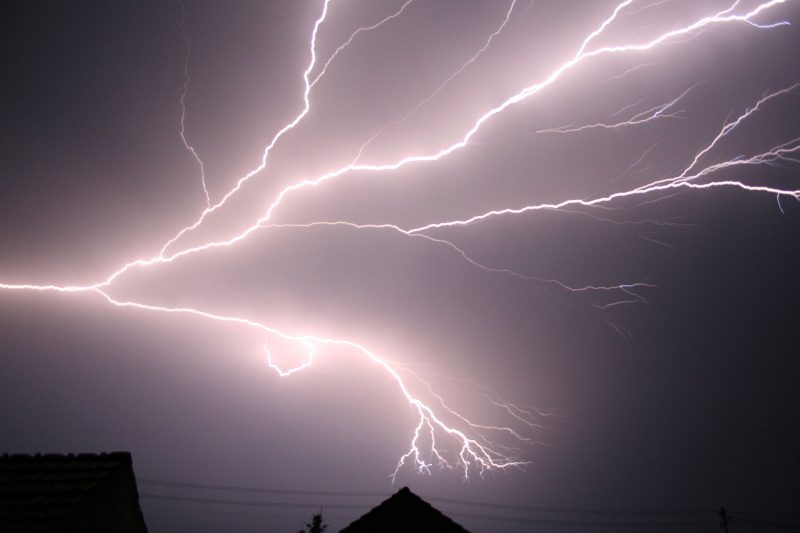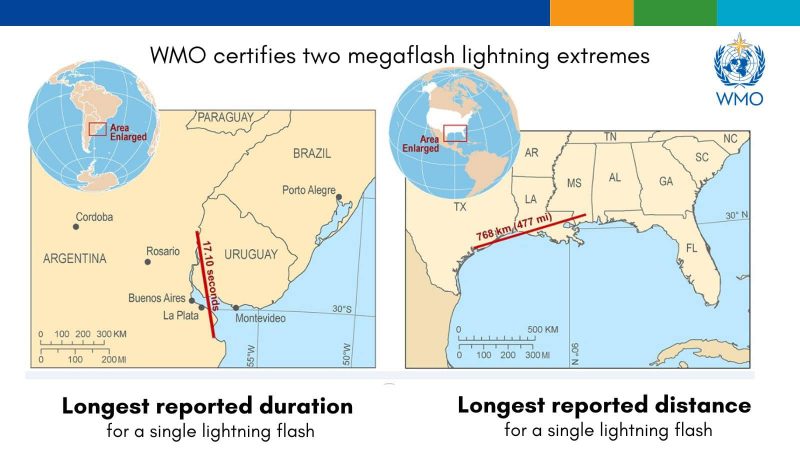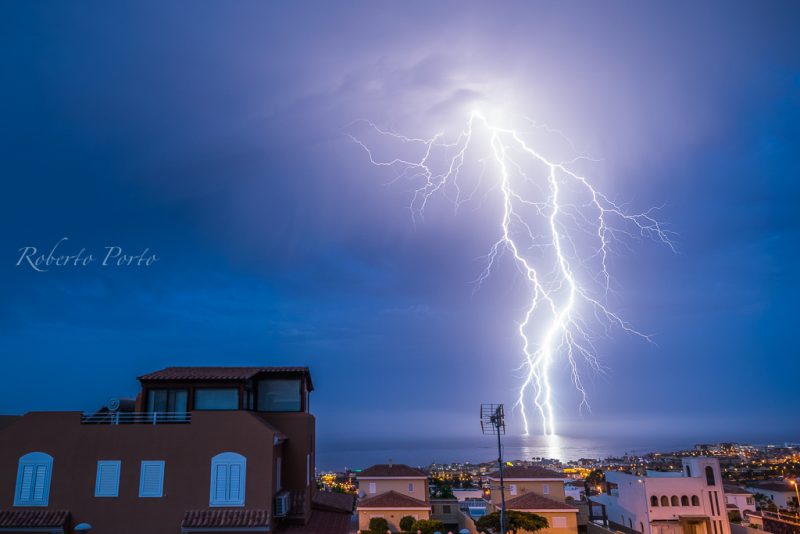
2 new world records for extreme lightning
The World Meteorological Organization (WMO) said today (February 1, 2022) that the new record-holder for longest single lightning flash took place over the southern United States in 2020. The flash lit up the sky from near Houston to southeastern Mississippi. This part of the U.S. is a known lightning hotspot. The record for longest single lightning flash is now 477.2 miles (768 km). The new record is 60 km longer than the previous record, set in Brazil, and verified two years ago.
A 2nd new world record, for greatest-duration lightning, took place over Uruguay and northern Argentina. This part of the world is also known for its intense lightning. The old record was 16.7 seconds. The new record is 17.102 seconds.
Both of these extreme events were cloud-to-cloud lightning flashes, taking place several thousand feet above the ground. So there was no danger to us on Earth’s surface.

The 2022 lunar calendars are here. Order yours before they’re gone!
What is a megaflash?
We’re hearing a new word for these events: megaflash. What is a megaflash? The great Capital Weather Gang at the Washington Post explained in 2020:
For years, lightning has been treated as a local event. It results from an imbalance of electrical charge. When the buildup of a charge difference overwhelms the dielectric strength of air, a spark jumps between the two charges.
But emerging research reveals that some lightning events may be mesoscale in nature, reaching the scale of the occasionally massive sprawling storm complexes that create them.
Large-scale bands or arcs of thunderstorms, known as mesoscale convective systems, can yield extensive electric fields. Once in a while, it’s possible for a disturbance in the field to trigger a lightning strike that will distribute charge over enormous sectors of that field.
These so-called megaflashes do exactly that, sparks flying over hundreds of miles.
But brewing these overachieving bolts isn’t an everyday occurrence. To create a massive lightning bolt, you need an equally gargantuan storm. That’s where South America’s vicious summertime storm complexes enter the equation.
The Post’s Capital Weather Gang went on to explain that mesoscale convective systems – thunderstorm complexes that stretch about over 60 miles (100 km) or more – are:
… a staple of the summertime in South America.
And indeed South America now holds the new world’s record for long-duration lightning, as mentioned above.
More intense storms and climate change?
CBS News reported today that the two new lightning records:
… are not linked to climate change.
And we also understand that no direct connection has been verified between longer-distance lightning – or longer-duration lightning – and climate change. But it’s perhaps worth noting that climate models do suggest we can expect more intense storms with stronger lightning as Earth’s climate continues to warm. Gavin Schmidt, NASA’s new Senior Climate Adviser, told EarthSky in December 2021:
Lightning is driven by the strength of the convective updrafts, so we expect it to increase with temperature. Also, as convective storms move poleward, we expect an increase in the range of lightning strikes, which can contribute to more wildfire ignition.
Read more: Intense storms from global warming, and a mission to study them.

Bottom line: The World Meteorological Organization said on February 1, 2022, that it has verified 2 new world records for lightning. To describe it, they’re using the word “megaflash.” Shout-out to EarthSky friend Benjamin Napier for the heads up!
The post Megaflash! 2 new world records for lightning first appeared on EarthSky.
from EarthSky https://ift.tt/zKLZDrIVR

2 new world records for extreme lightning
The World Meteorological Organization (WMO) said today (February 1, 2022) that the new record-holder for longest single lightning flash took place over the southern United States in 2020. The flash lit up the sky from near Houston to southeastern Mississippi. This part of the U.S. is a known lightning hotspot. The record for longest single lightning flash is now 477.2 miles (768 km). The new record is 60 km longer than the previous record, set in Brazil, and verified two years ago.
A 2nd new world record, for greatest-duration lightning, took place over Uruguay and northern Argentina. This part of the world is also known for its intense lightning. The old record was 16.7 seconds. The new record is 17.102 seconds.
Both of these extreme events were cloud-to-cloud lightning flashes, taking place several thousand feet above the ground. So there was no danger to us on Earth’s surface.

The 2022 lunar calendars are here. Order yours before they’re gone!
What is a megaflash?
We’re hearing a new word for these events: megaflash. What is a megaflash? The great Capital Weather Gang at the Washington Post explained in 2020:
For years, lightning has been treated as a local event. It results from an imbalance of electrical charge. When the buildup of a charge difference overwhelms the dielectric strength of air, a spark jumps between the two charges.
But emerging research reveals that some lightning events may be mesoscale in nature, reaching the scale of the occasionally massive sprawling storm complexes that create them.
Large-scale bands or arcs of thunderstorms, known as mesoscale convective systems, can yield extensive electric fields. Once in a while, it’s possible for a disturbance in the field to trigger a lightning strike that will distribute charge over enormous sectors of that field.
These so-called megaflashes do exactly that, sparks flying over hundreds of miles.
But brewing these overachieving bolts isn’t an everyday occurrence. To create a massive lightning bolt, you need an equally gargantuan storm. That’s where South America’s vicious summertime storm complexes enter the equation.
The Post’s Capital Weather Gang went on to explain that mesoscale convective systems – thunderstorm complexes that stretch about over 60 miles (100 km) or more – are:
… a staple of the summertime in South America.
And indeed South America now holds the new world’s record for long-duration lightning, as mentioned above.
More intense storms and climate change?
CBS News reported today that the two new lightning records:
… are not linked to climate change.
And we also understand that no direct connection has been verified between longer-distance lightning – or longer-duration lightning – and climate change. But it’s perhaps worth noting that climate models do suggest we can expect more intense storms with stronger lightning as Earth’s climate continues to warm. Gavin Schmidt, NASA’s new Senior Climate Adviser, told EarthSky in December 2021:
Lightning is driven by the strength of the convective updrafts, so we expect it to increase with temperature. Also, as convective storms move poleward, we expect an increase in the range of lightning strikes, which can contribute to more wildfire ignition.
Read more: Intense storms from global warming, and a mission to study them.

Bottom line: The World Meteorological Organization said on February 1, 2022, that it has verified 2 new world records for lightning. To describe it, they’re using the word “megaflash.” Shout-out to EarthSky friend Benjamin Napier for the heads up!
The post Megaflash! 2 new world records for lightning first appeared on EarthSky.
from EarthSky https://ift.tt/zKLZDrIVR

Aucun commentaire:
Enregistrer un commentaire